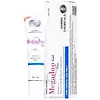What's inside
What's inside
 Key Ingredients
Key Ingredients

 Benefits
Benefits

 Concerns
Concerns

 Ingredients Side-by-side
Ingredients Side-by-side

Water
Skin ConditioningNiacinamide
SmoothingSilanediol Salicylate
EmollientGlycerin
HumectantAllium Cepa Bulb Extract
Skin ConditioningCitrus Aurantium Amara Fruit Extract
Skin ConditioningPropanediol
SolventPolyacrylate Crosspolymer-6
Emulsion StabilisingZinc PCA
Humectant4-Terpineol
MaskingSalicylic Acid
MaskingSalix Alba Bark Extract
AstringentAllantoin
Skin ConditioningAloe Barbadensis Leaf Powder
Skin Conditioning10-Hydroxydecanoic Acid
Skin ConditioningSebacic Acid
Buffering1,10-Decanediol
SolventCentella Asiatica Extract
CleansingAmylopectin
Dextrin
AbsorbentXanthan Gum
EmulsifyingLactic Acid/Glycolic Acid Copolymer
Skin ConditioningPolyvinyl Alcohol
Arbutin
AntioxidantSodium Ascorbyl Phosphate
AntioxidantPalmitoyl Sh-Tripeptide-5 Norisoleucyl Sh-Nonapeptide-1
Skin ConditioningMelaleuca Alternifolia Leaf Oil
AntioxidantPhenoxyethanol
PreservativeBenzyl Alcohol
PerfumingPotassium Sorbate
PreservativeWater, Niacinamide, Silanediol Salicylate, Glycerin, Allium Cepa Bulb Extract, Citrus Aurantium Amara Fruit Extract, Propanediol, Polyacrylate Crosspolymer-6, Zinc PCA, 4-Terpineol, Salicylic Acid, Salix Alba Bark Extract, Allantoin, Aloe Barbadensis Leaf Powder, 10-Hydroxydecanoic Acid, Sebacic Acid, 1,10-Decanediol, Centella Asiatica Extract, Amylopectin, Dextrin, Xanthan Gum, Lactic Acid/Glycolic Acid Copolymer, Polyvinyl Alcohol, Arbutin, Sodium Ascorbyl Phosphate, Palmitoyl Sh-Tripeptide-5 Norisoleucyl Sh-Nonapeptide-1, Melaleuca Alternifolia Leaf Oil, Phenoxyethanol, Benzyl Alcohol, Potassium Sorbate
Water
Skin ConditioningHamamelis Virginiana Extract
AntiseborrhoeicCentella Asiatica Extract
CleansingPolysorbate 60
EmulsifyingLactic Acid
BufferingCetyl Alcohol
EmollientGlycolic Acid
BufferingManganese Chloride
Skin ConditioningDimethicone
EmollientPhenoxyethanol
PreservativeZinc Oxide
Cosmetic ColorantPyridoxine Hcl
Skin ConditioningNiacinamide
SmoothingRetinal
Skin ConditioningBisabolol
MaskingSalicylic Acid
Masking
 Reviews
Reviews

Ingredients Explained
These ingredients are found in both products.
Ingredients higher up in an ingredient list are typically present in a larger amount.
Centella Asiatica Extract (Centella) is derived from an herb native to Southeast Asia. It is famous for its anti-inflammatory and soothing properties.
Centella is rich in antioxidants and amino acids, such as Madecassic Acid and Asiaticoside.
Studies show the compounds in centella help with:
The combination of all these properties makes centella effective at soothing, hydrating, and protecting the skin.
Other great components of centella include Vitamin A, vitamin C, several B vitamins, and Asiatic Acid.
Fun fact: Centella has been used as a medicine and in food for many centuries. As a medicine, it is used to treat burns, scratches, and wounds.
Learn more about Centella Asiatica ExtractNiacinamide is a multitasking form of vitamin B3 that strengthens the skin barrier, reduces pores and dark spots, regulates oil, and improves signs of aging.
And the best part? It's gentle and well-tolerated by most skin types, including sensitive and reactive skin.
You might have heard of "niacin flush", or the reddening of skin that causes itchiness. Niacinamide has not been found to cause this.
In very rare cases, some individuals may not be able to tolerate niacinamide at all or experience an allergic reaction to it.
If you are experiencing flaking, irritation, and dryness with this ingredient, be sure to double check all your products as this ingredient can be found in all categories of skincare.
When incorporating niacinamide into your routine, look out for concentration amounts. Typically, 5% niacinamide provides benefits such as fading dark spots. However, if you have sensitive skin, it is better to begin with a smaller concentration.
When you apply niacinamide to your skin, your body converts it into nicotinamide adenine dinucleotide (NAD). NAD is an essential coenzyme that is already found in your cells as "fuel" and powers countless biological processes.
In your skin, NAD helps repair cell damage, produce new healthy cells, support collagen production, strengthen the skin barrier, and fight environmental stressors (like UV and pollution).
Our natural NAD levels start to decline with age, leading to slower skin repair, visible aging, and a weaker skin barrier. By providing your skin niacinamide, you're recharging your skin's NAD levels. This leads to stronger, healthier, and younger looking skin.
Another name for vitamin B3 is nicotinamide. This vitamin is water-soluble and our bodies don't store it. We obtain Vitamin B3 from either food or skincare. Meat, fish, wheat, yeast, and leafy greens contain vitamin B3.
The type of niacinamide used in skincare is synthetically created.
Learn more about NiacinamidePhenoxyethanol is a preservative that has germicide, antimicrobial, and aromatic properties. Studies show that phenoxyethanol can prevent microbial growth. By itself, it has a scent that is similar to that of a rose.
It's often used in formulations along with Caprylyl Glycol to preserve the shelf life of products.
Salicylic Acid (also known as beta hydroxy acid or BHA) is a well-known ingredient for treating skin that struggles with acne and clogged pores. It exfoliates both the skin's surface and deep within the pores to help clear out buildup, control oil, and reduce inflammation.
Unlike AHAs (alpha hydroxy acids), salicylic acid is oil-soluble. This allows it to penetrate into pores which makes it especially effective for treating blackheads and preventing future breakouts.
Salicylic acid is also known for its soothing properties. It has a similar structure to aspirin and can calm inflamed or irritated skin, making it a good option for acne-prone skin that is also sensitive.
Concentrations of 0.5-2% are recognized by the U.S. FDA as an over-the-counter topical acne product.
It can cause irritation and/or dryness if one's skin already has a compromised moisture barrier, so it's best to focus on repairing that before introducing this ingredient into your routine.
While salicylic acid does not increase sun sensitivity, it’s still important to wear sunscreen daily to protect your skin.
If you are looking for the ingredient called BHA or Butylated Hydroxyanisole, click here.
Learn more about Salicylic AcidWater. It's the most common cosmetic ingredient of all. You'll usually see it at the top of ingredient lists, meaning that it makes up the largest part of the product.
So why is it so popular? Water most often acts as a solvent - this means that it helps dissolve other ingredients into the formulation.
You'll also recognize water as that liquid we all need to stay alive. If you see this, drink a glass of water. Stay hydrated!
Learn more about Water